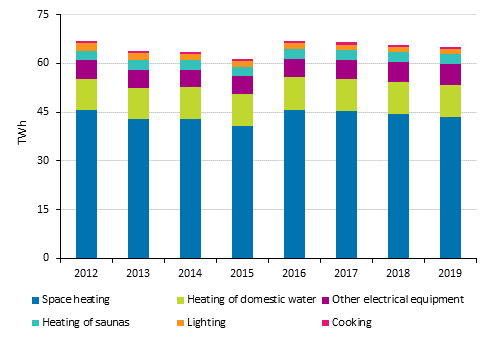Published: 19 November 2020
Energy consumption in households fell further in 2019
The energy consumed in housing amounted to around 65 terawatt hours (TWh) in 2019. Consumption fell by good one-half TWh from the previous year. Consumption of indoor living space heating fell by two per cent from 2018 to 2019. The weather was warmer in Southern Finland than in the previous year. The growth in the number and volume of dwellings continued. The share of household appliances in households’ energy consumption remained at 13 per cent, even though the energy consumption of the appliances grew. The data are based on Statistics Finland's statistics on energy consumption in households.
Energy consumption in households in 2012 to 2019

Heating of residential buildings amounted to close on 67 per cent of energy consumption in housing, heating of domestic water to 15 per cent and heating of saunas to five per cent. The share of electrical equipment, cooking and lighting was 13 per cent. Housing accounts, on average, for 20 per cent of the final energy consumption. Housing also includes free-time residences.
Good one-third of energy consumption in housing was electricity in 2019. Nearly one-third of consumption was district heat and good one-fifth wood. Altogether 22.5 TWh of electricity was consumed; the consumption has remained more or less unchanged for four years. Forty-six per cent of electricity was used to heat indoor areas and 38 per cent for household appliances. The remainder of electricity was used to heat domestic water and saunas.
Heating of residential buildings consumed 43 TWh of energy in 2019. Consumption decreased by two per cent from the previous year. The most common sources of energy for heating indoor spaces were district heat, wood and electricity, the share of which was 82 per cent of the energy consumption for heating indoor spaces. The next most common energy source was heat pump energy.
The use of heat pumps for heating has grown significantly from the start of the millennium. This is visible in the statistics as growth in both heat pump energy and electricity use of heat pumps. Heat pump energy refers to the energy extracted with heat pumps from the environment. The electricity use of heat pumps is included in electricity consumption of heating in the statistics on energy consumption in households.
In addition to the area to be heated and the energy efficiency of the building stock, the need for heating energy is also affected by the outdoor temperature. Its changes are monitored with heating degree days. The year 2019 was warmer in Southern Finland than 2018, in Northern Finland the situation was the opposite. The warmest year of the reference period was 2015.
Around three TWh of energy was used for heating saunas in 2019. Nearly two-thirds of energy were wood and good one-third electricity. The energy consumption of heating domestic water was 10 TWh.
The energy consumption of household appliances, that is, cooking, lighting and other electrical equipment, was around 8.5 TWh in 2019. Appliances accounted for 13 per cent of the entire housing energy. One per cent of this was used on cooking, that is, using cookers and ovens, and good two per cent on lighting. Ten per cent was used in other electrical equipment. They include small appliances for cooking, refrigeration equipment, washing machines, tumble dryers, televisions and computers with their accessories, lifts, and car interior heating.
With respect to the consumption of heating energy in indoor spaces, domestic water and saunas, the statistics on energy consumption in households are based on Statistics Finland's calculation model where various sources were utilised. Part of the data have been estimated as the interval between the inquiries used as data sources has become longer.
The concepts of the statistics correspond to the divisions of the European Union's Regulation on energy statistics concerning energy use in households. Based on the division, heating of indoor spaces and domestic water, cooking, electrical equipment, and heating of saunas are reported separately.
Source: Energy consumption in households 2019, Statistics Finland
Inquiries: Virve Rouhiainen 029 551 3395, energia@stat.fi
Head of Department in charge: Mari Ylä-Jarkko
Publication in pdf-format (272.7 kB)
- Tables
-
Tables in databases
Pick the data you need into tables, view the data as graphs, or download the data for your use.
Appendix tables
- Figures
Updated 19.11.2020
Official Statistics of Finland (OSF):
Energy consumption in households [e-publication].
ISSN=2323-329X. 2019. Helsinki: Statistics Finland [referred: 18.12.2025].
Access method: http://stat.fi/til/asen/2019/asen_2019_2020-11-19_tie_001_en.html

